
Cheval began the building in April 1879 when he was 43 years old.[6] He reported:
I was walking very fast when my foot caught on something that sent me stumbling a few metres away, I wanted to know the cause. In a dream I had built a palace, a castle or caves, I cannot express it well… I told no one about it for fear of being ridiculed and I felt ridiculous myself. Then fifteen years later, when I had almost forgotten my dream, when I wasn’t thinking of it at all, my foot reminded me of it. My foot tripped on a stone that almost made me fall. I wanted to know what it was… It was a stone of such a strange shape that I put it in my pocket to admire it at my ease. The next day, I went back to the same place. I found more stones, even more beautiful, I gathered them together on the spot and was overcome with delight… It’s a sandstone shaped by water and hardened by the power of time. It becomes as hard as pebbles. It represents a sculpture so strange that it is impossible for man to imitate, it represents any kind of animal, any kind of caricature. I said to myself: since Nature is willing to do the sculpture, I will do the masonry and the architecture.[7][8]
For the next thirty-three years, Cheval picked up stones during his daily mail round and carried them home to build the Palais idéal.[1] He spent the first twenty years building the outer walls. At first, he carried the stones in his pockets, then switched to a basket. Eventually, he used a wheelbarrow. He often worked at night, by the light of an oil lamp.[1][2]
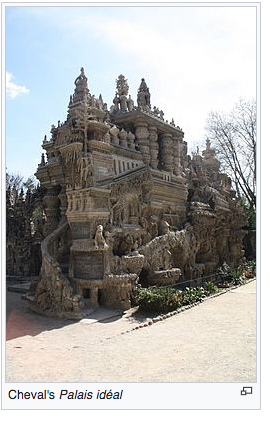
The palace materials mainly consist of stones (river washed), pebbles, porous tufa and fossils of many different shapes and sizes. When a visitor first comes up on the palace, the first face they see is the southern facade. This is approximately 26 metres long and up to 10 metres high. The decoration resembles aspects of both the Brighton Pavilion and Gaudí‘s Sagrada Família. Cheval did not travel and he had even given himself the title of peasant, so even though the qualities resemble those pieces of art, he had never seen them.[6] Three giant stones, each with doll-like faces, standing about 10.5 high, serve not only as decoration but as a support system for the Barbary Tower, with an elegant spiral staircase lined with swans made of cement leading up to it.[4] The tall stones were named Vercingétorix, Archimedes and Caesar. Cheval hand-carved the names into each individual figure.[6]
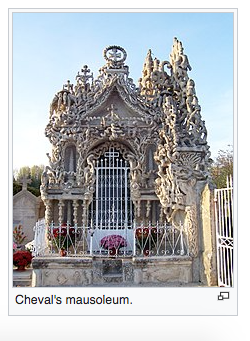
The north face exhibits a long path dotted with large openings to provide plentiful light leading into the heart of the palace itself. This facade is very forest-like with walls coated in moss and massive seaweed. The ceiling, swirling patterns of pebbles and shells that outline the chandeliers. Upper walls are lined with horizontal bands with animals carved into them in an Egyptian-like style. Other animals on the north face facade include two ostriches (presumably mother and father) and an ostrich chick, a 1.2m tall camel,[6] flamingos, octopi, lions, dragons, and a polar bear.[4]
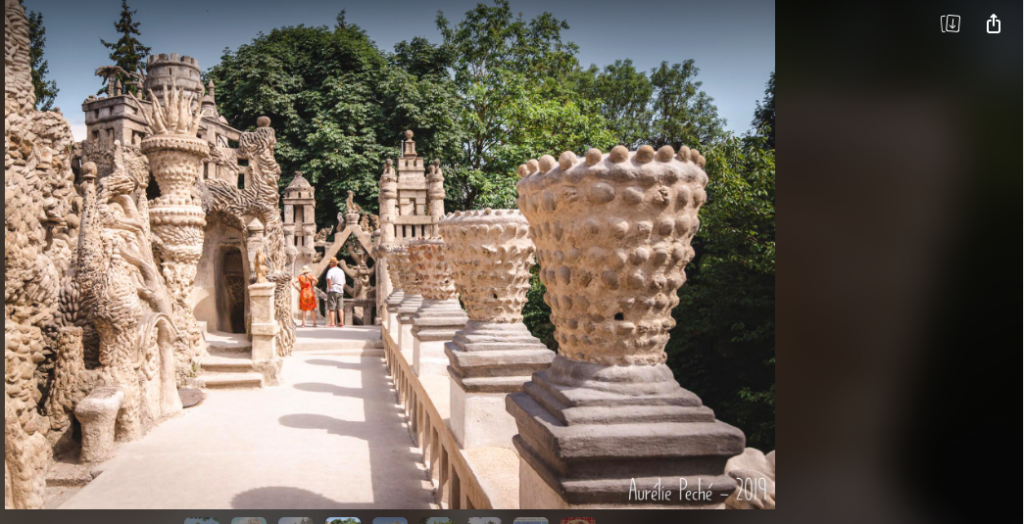
Ideal Palace 3
The east facade took the longest to build before, a shocking 20 years. This face includes ‘The Temple of Nature’, an Egyptian style temple-like structure supported by large, thick sandstone columns. It includes two waterfalls called the Source of Life and the Source of Wisdom.[3]
The Palais is a mix of different styles with inspirations from Christianity to Hinduism. Cheval bound the stones together with lime, mortar and cement.[1][2]
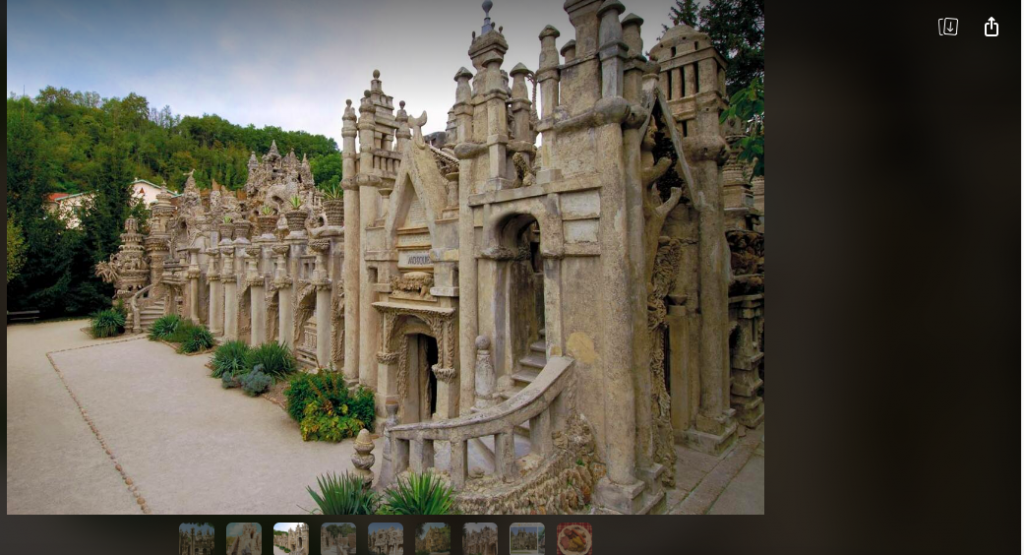
Ideal Palace 4
The palace is sprinkled with short quotes and poems hand-carved by Cheval himself. Some examples being “If you look for gold you will find it in elbow grease.”, “The Pantheon of an obscure hero.”[6] “The work of one man”, “Out of a dream I have brought forth the Queen of the World”, “This is of art, and of energy”, “The ecstasy of a beautiful dream and the prize of effort”, “Dream of a peasant”, “Temple of Life”, and “Palace of the Imagination”.[4] Perhaps the most iconic phrase he inscribed on the wall reads “1879-1912 10,000 days, 93,000 hours, 33 years of struggle. Let those who think they can do better try.”[6]
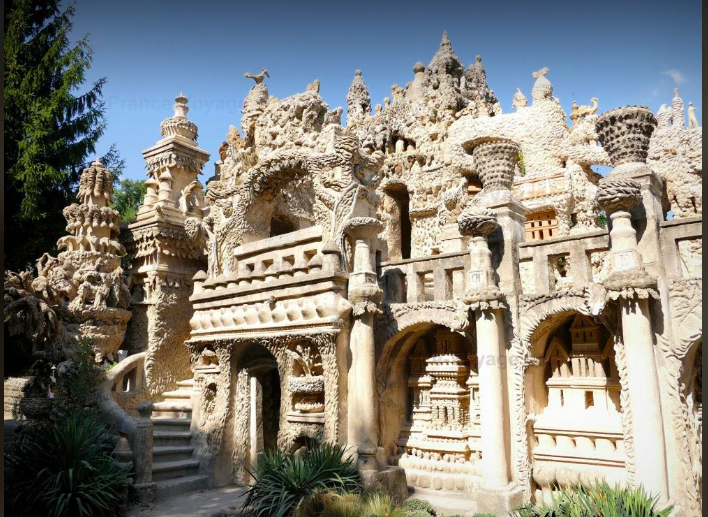
Ideal Palace 5
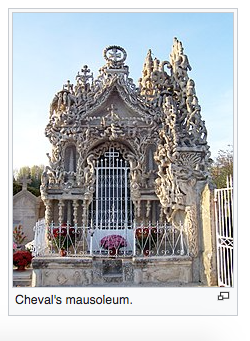
Ideal Palace 6 Mausoleum
Cheval wanted to be buried in his palace. Because that is illegal in France, he spent eight more years building a mausoleum for himself in the Hauterives cemetery. He died on 19 August 1924, about a year after he had finished building it, and is buried there.[1][2]
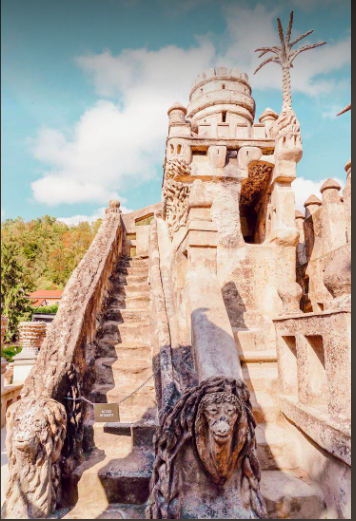
Ideal Palace 7
Recognition
Just before his death, Cheval received recognition from figures including André Breton, Bernard Buffet, Jean Tinguely, Niki de Saint Phalle, Robert Doisneau, and Pablo Picasso.[9] His work is commemorated in an essay by Anaïs Nin. In 1932, the German artist Max Ernst created a collage titled The Postman Cheval. The collage belongs to the Peggy Guggenheim Collection and is on display there. In 1958, Ado Kyrou produced Le Palais idéal, a short film about Cheval’s palace.
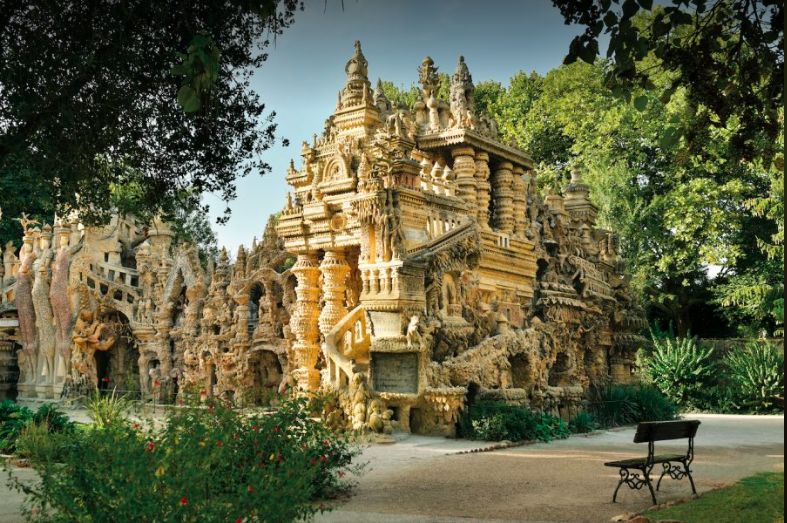
Ideal Palace 8
After admiring Cheval’s work, Picasso created a series of drawings telling a narrative, in a cartoon fashion, which is now recognized as Facteur Cheval sketchbook in 1937. Picasso drew him as twisted, hybrid-like creature (or beast), carved with the initials of the French postal service (P.T.T) on his skin, dressed in typical postman’s attire, holding masonry tools and a letter. The creature was standing in front of his creation. In the drawing, Picasso took a humorous route sketching Cheval’s body in the shape of a horse and his head that of a bird. Picasso did this in an effort to make a sort of pun about Cheval’s name and career given birds are messengers (as Cheval was a postman) and the meaning of Cheval is horse.[4]
In 1969, André Malraux, the Minister of Culture, declared the Palais a cultural landmark and had it officially protected.[2] In 1986, Cheval was put on a French postage stamp.[2]

Ideal Palace 9
In 2018 French director Nils Tavernier released the feature film L’incroyable histoire du facteur Cheval, English title: Ideal Palace, about Cheval’s life and work, with Jacques Gamblin starring as Postman Cheval.[10]
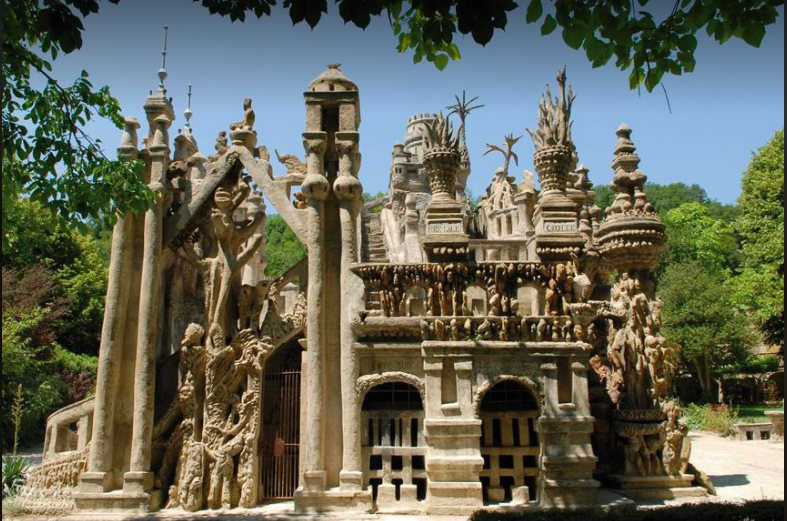
Ideal Palace 10
JL Comment:
I was introduced to the Ideal Palace by a friend – CF. Here is my first initial reaction to the work on seeing limited and rather dark set of photos.
‘I do find PC’s work interesting and in many ways.
- Time, Effort and Commitment of PC. Amazing and impressive. Who could not be? Could be compared with other toilers in the fields, including ourselves, although not to our advantage, in most cases. My writing of books, however, comes to mind. And you? WMBT!
- Life of PC. What was the cost of 1 – T,E and C? To his family? An escape from them? Part of an incipient Asperger’s syndrome? To himself? A response to existential angst? WikiP not very helpful here. What do you think?
- Ideal Palace – Bricolage, Artisanat or Art? I don’t really like it, although the photos do not do it justice. Looks like Topsy and just grew – a combination of stones and lime+mortar. Bricolage for sure. DIY gone over the top? However, clearly there is artisanat too – some symmetry, some passing symbols……Not art, although cited by artists. If art, the case needs to be made. Can you make it? Would be interested in your efforts and would join in the fun…….
My garden is DIY and bricolage. Could be more, but I can’t see it at this time. The wall backing/fronting might defend itself for something more. What do you think? Remember mine is functional – ‘occuper le terrain’ and ‘controler les mauvaises herbes’. PC was buried near his. Now there’s a thought…….